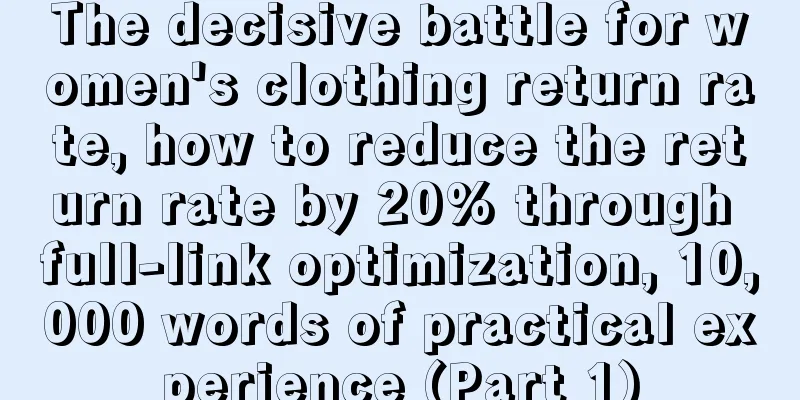The decisive battle for women's clothing return rate, how to reduce the return rate by 20% through full-link optimization, 10,000 words of practical experience (Part 1)

The content of this article is mainly applicable to shelf e-commerce scenarios, such as Tmall and Taobao. This article will not focus on live streaming e-commerce for women's clothing. In addition, this article will be explained from multiple modules such as products, supply chain, consumers, etc., so the content is relatively long. In order to consider the reading experience, it is divided into two parts: (upper) and (lower). The women's clothing e-commerce market has been sluggish and tragic this year. Now most peers on social media are saying that sales have fallen sharply this year. I feel the same way. Not only has our sales dropped significantly, but I have a benchmark store that I have been imitating and learning from, learning its style, product line, vision, and so on. Last year, he achieved monthly sales of 1.2 million for a few months, but this year, his sales dropped directly to 200,000 per month, which is a drop of 80%. I can't fix it all at once... Including many e-commerce groups I am in, many colleagues complain every day about lack of traffic, no sales, etc. In short, there is widespread misery. In addition to declining sales and a bad economic environment, the surge in return rates has also made many bosses very painful. I remember when I first entered the industry a few years ago, I discussed the issue of return rate with other bosses, and the data range given by everyone was often around 40% to 60%. Most people agree that a 50% return rate should be the industry average (mainly Taobao and Tmall) If you sell 10 pieces and return 5, you can get half of the price back, which is acceptable to everyone. The return rate of my women's clothing e-commerce business in the past few years has remained basically stable at around 40% to 45%. But this year, when I looked through Xiaohongshu and Douyin, and talked with many colleagues, everyone complained that the return rate this year has soared, much higher than in previous years, especially for live broadcasts of women's clothing, where the return rate has even reached 80%. It's really scary to think about it. Even if you sell 1 million per month, you still have to return 800,000, and finally collect 200,000. If it keeps going on like this, then not only will you not make any money from selling women's clothing, you will even lose more. Because the loss from returned goods is like a bleeding wound, it is more serious than we imagined. 1. Losses from returnsWhen a product is returned, the first thing you lose is your promotion fee. For example, if you spend 30 yuan to get a customer to make a deal, but the customer returns the product later, your promotion fee is gone. Then the loss of return is the courier fee. We charge 3 yuan for one courier fee. If the product is returned, this money is gone. Then, if you return the product, you will lose the shipping insurance. If you don’t open the shipping insurance now, the conversion rate will be very poor, and you can’t apply for many activities. The shipping insurance has now risen to 4 to 5 yuan. If the customer returns the product, you will not make any money, but lose 4 yuan on the shipping insurance. When you return the product, you will lose an outer packaging bag and an inner packaging bag, which is 0.3 yuan each, so you lose another 1 yuan. Then when the goods are returned, you have to arrange for someone to unpack, sort, iron, and store them in the warehouse. These labor costs are invisible. When there are a lot of returns, the warehouse will have a backlog of packages, and they are all piled up there. Because the quantity is too large, the warehouse staff cannot handle it, and if they don't handle it carefully, the returns may still have residues of customers' lipstick, foundation, hair, and wrinkled clothes. However, because the quantity of returns is too large, the warehouse staff can't take care of it, and they don't handle it cleanly, so they put the goods back into the warehouse. As a result, these problematic products are sent out again. When the customer unpacks, they realize that these products have been worn by someone before, and they get angry and apply for a return again. Then the returned goods came back, the warehouse staff couldn’t do the quality inspection, so they put them back into the warehouse, and then sent them out again… This is a chain of returns. The little money you worked hard to earn is wasted in these returns. Of course, you will say that the above are all small money, and the losses are all small money. As long as you make it, these small money can be earned back. The biggest risk of returns is that it is easy to cause inventory risk. Inventory is not small money, it is a lot of money. Generally speaking, after you have been in business for a long time, it is difficult to purchase a lot of inventory if you are purchasing goods. After all, you are not smart, so just purchase as much as you sell. But the most worrying thing is the high return rate. After the products are sold, they are returned. The returned products cannot be sold again and directly become inventory. In particular, the more popular the sales, the greater the risk. So many people make women's clothing, which sells very well and has high sales, but then they find that they are not making money, or even losing money. They never see any money and their cash flow is always in a tight state. Where did the money go? All the compensation was for the loss of returned goods and the inventory of returned goods. I think that at this stage, when doing women's clothing e-commerce, especially in such a harsh living environment, it is imperative to place the two goals of [increasing sales] and [reducing return rate] on an equal footing. The former affects sales and whether you can build your business. The latter affects your profits, whether you can actually make money and not lose money. Most bosses and operators only focus on the former, and try every possible way to increase sales every day, such as live streaming, advertising, and spending money. Sales are indeed very rapid. But the return rate is 70% or 80%. A lot of products are sold and all are returned. In order to offset the loss from the return rate, we even continue to increase sales, thinking that the return rate is high, but as long as we sell a lot, we will always make money. This is actually very risky, as a lot of costs are lost in the return process, which means the more you sell, the more you lose. Therefore, only when high sales volume and low return rate exist at the same time can you truly strike gold in this industry. 2. Be realistic about return ratesFirst of all, we need to have some realistic understanding of the return rate. Some of the reasons for the surge in return rates are difficult to change, and you can only try to avoid them. For example, the return rate will definitely increase as your sales scale increases. Some friends said, "Brother Dong, I sold 5 pieces of this dress, but only returned 1 piece. The return rate is only 20%. Isn't it very low? Hahaha!" Such a return rate is not representative because you sold too few products, the data sample is too small, and the random fluctuation is too large, so it is not representative. Generally, the return rate displayed after selling 30, 50, or even 100 items is of reference value. In this process, everyone will find that the better the product sells, the higher the return rate. For example, for a pair of pants, when you sell 300 pieces, the return rate may be only 50%, and a return of half is acceptable. But when you sell 1,000, 2,000, or even 3,000 pieces, if you do not perform certain product optimizations, its return rate is likely to rise to 60%~65%. Because it has become a hit in the market, you and the platform are pushing this product to more people and more traffic. Many people who are not the target users of this product will also follow the trend and buy it because the product is so popular. It’s just like buying stocks, everyone wants good things, even if they may not be suitable for them. Therefore, after creating a hit product, you must try every possible way to suppress the return rate. It can have a certain growth, but you cannot let it soar. Secondly, the return rate of some categories is indeed relatively high. For example, the dress category has a high return rate. I think the return rate of dresses in the industry is basically set at more than 60%, because this category has high requirements for user adaptability. The style, color, pattern, elements, price, wearing feeling, and fabric may all become reasons for customers to return the dresses. In the category of pants, the return rate is also relatively high. Each person's leg shape, leg length, hip width, waist circumference, hips, thick legs or thin legs will cause the wearing effect of pants to be quite different, so the demand for a good pair of pants is always strong in the market, and every consumer hopes to have a pair of pants that perfectly fits his or her body shape. Of course, some products have high return rates, while others have low return rates. For example, T-shirts, underwear, hoodies, and sweaters have relatively low return rates. You say that's great! Then I'll make T-shirts and underwear! They have low return rates! It is indeed low, but it just doesn’t make money. It is too cheap, the gross profit margin is low, and the competition is fierce. Therefore, business is often relative. Although some categories have a high return rate, they are popular in the market, have great demand, and are priced high, so they are easy to sell out and have a good gross profit, so you can make more money. The return rate of some categories is low, but the selling price is also very cheap. If you can’t sell them at a high price, you can’t make much money. So it really is up to you to choose and know how you feel. There are also some clothing styles that have a high return rate. For example, hot girl style, European and American style, trendy cool style, new Chinese style, dark style, these products with strong stylization will inevitably have a high return rate because they require consumers to have a strong ability to control style. Especially this year's new Chinese style, the return rate will definitely be high, because most people cannot control this style. It has very high requirements on figure, temperament, makeup, and matching. Many consumers think the products look good, but after buying them, they find that they are not suitable for them, so they will definitely return them. There are also some styles of rich socialites and beautiful ladies. If you don’t have a very precise ability to attract new customers and just sell them in a direct and extensive manner, the products will basically be returned, because these styles have high requirements on the temperament, body shape, and appearance of the consumers. I saw two sisters starting a women's clothing live broadcast business on Xiaohongshu. They sold exquisite lady-style clothes through Xiaohongshu live broadcast. The sales were very good. They achieved a monthly sales of 400,000 in two months. I think they have extraordinary sales ability, but the return rate killed them. They revealed that the return rate was 85%, and they returned 85 out of 100 pieces. In the end, this business could not continue. The main reason for such a high return rate is that the target group for conversion is not accurate. Although there is strong sales ability, the target group is not right and the style is also very picky, so after conversion, all the products will inevitably be returned. Shipping insurance is not the main reason for the high return rate. This statement may offend some people. Many businesses believe that it is precisely because returns and exchanges are cost-free for consumers that the return rate has gradually increased. But from my actual observation, I often count the return rates of my own products. If the return rate of a certain product soars to 60% or 70%, then there must be serious quality problems with the product, which may be due to the type, target group, style, production, quality inspection, quality, price, touch, etc. Eventually, we will find out the product problems. The return rate of some of my products is very low, as low as 35%, and some are as low as 30%. Thousands of them have been sold, and the shipping insurance is still provided. I think there is not much necessary relationship between whether or not to open freight insurance and the return rate of the product. We must have the right mindset. If you don’t, you will always think, oh it’s all the fault of the freight insurance, which has become more and more indulgent to consumers, making returns casual, so the return rate has become higher! If you keep holding on to this mentality, it will be difficult for you to find problems within yourself and optimize these things, and in the end your business will become increasingly frustrated. The main function of freight insurance is to increase conversion rate, and more importantly, to drive strong conversion, giving consumers a feeling that this product is very good, but I am afraid of being at a disadvantage, I am afraid that if I buy it, it will not be suitable, and I will have to pay the express fee to return it. With freight insurance, you don’t have to worry and can buy with confidence. Freight insurance is mainly to encourage consumers to be brave enough to try and not be afraid. It is very important to drive customers to place orders. If the customer does not place an order, even if your product is suitable for her, she will not know it! Another very important function of freight insurance is that if a customer feels that your product is not good, she can return it without paying any cost and with less risk of arguing with you. If you don't have shipping insurance, consumers will feel that your product is not worth the money after receiving it, and they will have to pay for the return shipping. They will definitely feel upset and give you a bad review. In fact, for most consumers, the entire process from seeing a product to repeatedly selecting, comparing, and thinking, paying dozens or hundreds of yuan to place an order, and then waiting for delivery is actually very costly. Everyone is very busy and will not have nothing to do but place an order, pay, receive, and return the product. Wouldn't it be nice to use this time to date, watch TV series, go shopping, and drink milk tea? Therefore, after paying, most customers sincerely hope to get the product that suits them and what they want, and keep it. 3. Some return rates are related to time nodesFor example, when a style is at the end of its sales period, the return rate will definitely soar. And you can’t stop it unless you take it off the shelves. For example, you sell a pair of pants that are relatively thin and suitable for autumn wear, and they sell well. Then winter comes and the weather gets cold, and your pants are out of season, but you can’t resist the long-tail traffic and customers who want to try placing orders. But after getting the product, the customer will immediately feel that the product is good, but a bit thin and cannot be worn when the weather is cold, so they will return it first. The opposite is true when the weather gets warmer. For example, in March, when we enter spring and the weather is warmer, some people will still buy down jackets and thick sweaters. After getting them, they realize that it is too late to wear them, so they will inevitably return them. There is nothing you can do about this kind of return, after all, some customers do realize it too late. There is also a positive correlation between some return rates and customers' impulse buying. The more impulsive and anxious the consumer is, the more likely they are to return the product. This is why there is a saying that “urgent orders are not accepted”. The consumer did not think carefully and just went for it, paid for the product, and when he got it, he found that it was not suitable for him and immediately returned it. So relatively speaking, the return rate of live streaming e-commerce is higher than that of shelf e-commerce. Shelf e-commerce requires customers to at least add items to cart, and they will also do a lot of price comparisons, observation, and waiting, so by the time they place an order, they have basically completed a round of thinking. In short, some factors that lead to high return rates are difficult to avoid unless you make overall adjustments, such as not doing this category or this style. We must have a realistic understanding of the return rate and make great efforts to optimize where it can be optimized. 4. Focus on solving returns and refundsRefunds for women's clothing are divided into two categories (the small probability of intercepted refunds and refunds will not be discussed for the time being) The first one is: [Customer payment] - [Shipment] - [Customer receipt] - [Return and refund] The second one is: [Customer paid] - [Item not shipped yet] - [Apply for a refund directly]. For the second situation, where you apply for a refund for an order that has not been shipped, I don't think you need to worry too much about it. Because part of this batch of orders is to fill in the order and get a discount if you spend a certain amount, your product may be recommended by the system, or it may be in her shopping cart and just be used to fill in the order. The customer pays and then gets the refund within seconds. There is no way to solve this problem because your product itself is not the customer's priority demand and is just used to fill the order. Some customers are impulsive and place an order passionately but then gradually calm down, or they get tired of waiting and don’t want the product anymore, so they apply for a refund. What you can do for this kind of order is to ship it as soon as possible, the sooner the better, and ship it out as soon as possible before her impulse subsides. In short, the optimization you can do is actually quite limited. We still need to focus on orders that are returned after shipment, after all, the losses in this part are the greatest. Because once the goods are shipped, the costs of logistics, packaging, after-sales and so on will start to be incurred. 5. Optimize from the whole linkOur bosses usually check Xiaohongshu and Douyin, and have seen some methods to reduce the return rate there, but from my observation, these methods are mainly single-point. It cannot be said that there is no effect, but consumers actually have various reasons for returning products, and it is difficult to significantly reduce the return rate by relying solely on single-point optimization. It is still necessary to optimize the entire chain from products, supply chain, warehouse quality inspection, consumers, etc. to effectively reduce the return rate to 40%~50% and avoid the situation where the more you sell, the more returns you get. Next, I will use a lot of space to explain the solutions for each module. 6. Start with the product firstI want to emphasize again that the entire process of consumer selection, comparison, payment, receipt, trying on and return is actually very long. Most people don't have the leisure to buy a bunch of products and then return them for fun. The main reason for most returns is that the product is not suitable, and this "product is not suitable" includes many aspects. The first one is [the goods are not the same as the pictures] One of the important reasons for the high return rate on the product side is that the goods do not match the description. Currently, 60% of women's clothing e-commerce merchants and supply chains rely on following popular items and selling imitations. For example, a model of skirt sold by online celebrity store A was very popular, with more than 2,000 pieces sold. Then the whole industry began to follow suit. Offline stalls and 1688 stores would directly refer to the product patterns of online celebrity store A and ship the products. Then many small and medium-sized stores would purchase goods from the stalls and directly use pictures of the online celebrity store or pictures of similar styles to sell the same style or imitations. Of course, the price is much cheaper than the original version from online celebrity store A. Internet celebrity store A sells it for 259 yuan (Internet celebrity stores usually sell it at a higher price), then everyone else will follow suit and sell their imitations for 159 yuan, 139 yuan, or even 99 yuan, thus creating price differentiation. We are not discussing moral issues here. After all, the establishment of every business model means there is a huge demand behind it. Many consumers may not have a high consumption level and cannot afford a 259 yuan skirt, or think it is not worth spending so much. Then she will look to buy a substitute that costs 159 yuan, 129 yuan, or even 99 yuan. Where there is demand, there is a market. It's just like high-end imitations of luxury goods. Some people can't afford a 20,000 yuan Chanel, so it's also good to buy a 2,000 yuan high-end imitation Chanel. Then why is the return rate so high for counterfeits and imitations of popular products? Because no matter it is a factory or a stall, the imitations of the originals are always not quite up to par, not careful enough, and not quite like the original. It certainly won't be too similar, everyone is so busy. The factory has to make money every day, and a large number of money every month, so how can they have the energy to grasp a good imitation? Many factories and stalls even rely solely on pictures to make payments, without comparing the actual products (because buying the actual products is costly). This only means that the appearance is similar, but the style, wearing feel and display effect are completely different. When I'm selecting styles, I will also choose some imitation styles appropriately, but every time I get the goods and ask a girl to try them on, I feel that there is a big difference between them and the originals. When I was choosing a dress before, there was a little white suspender dress that caught my eye. This little white dress is a hot-selling item in a certain Internet celebrity store. The style is simple, but fresh and beautiful. It is suitable for the general public but also a little exquisite. It is slimming and makes you look thin. However, the price is a bit expensive, costing nearly 300 yuan. At this point, there are already suppliers on the market that have produced imitations. If you make a low-priced model and sell it for less than 150 yuan and differentiate it from the original, there is still a great chance. But after receiving the real thing, I arranged for someone to try it on and was very disappointed. Because although the pattern, color, and style are very similar to the original, you will feel that this imitation is really ugly when worn on the body. Why is it ugly? Because the pattern is wrong. We carefully analyzed the original pictures and found that the original had some small curves on the chest and waist. These small curves are not noticeable at first glance, but they make the pattern more close-fitting and have a good slimming effect. The imitations are crude, or are purely made based on pictures without comparing with the real thing (the original costs nearly 300 yuan per piece, and it is too expensive for suppliers to buy imitations), so the curved parts are processed into straight lines, which makes it feel like wearing a lampshade when worn on the body, and it is ugly. If such a product is put on the shelves for sale, customers will definitely be disappointed after buying it. The pictures look good (the pictures of popular online stores and hot-selling stores must look good), but after getting it and putting it on, it doesn't look like the picture at all, it's far from the picture, and customers will definitely return the product. We encounter similar situations every time we choose a style, for example, we previously chose a popular floral skirt on the market. After we got the products, we felt that they were basically the same, but for some reason, the imitations were filled with a cheap feeling. Later I found out where the cheapness was. The color of the lining was wrong. The original lining used a dark color, which fit well and looked very high-end and textured. The lining of the imitation version is made in a light color, and the fit with the outer skirt is very messy. Even though it looks almost the same when worn outside, it still looks very cheap. So now there are many stores that put up online pictures, sell imitations, and sell them at low prices, and then have a very high return rate. This is because you used online pictures to raise consumers' expectations, and then used low prices to lure them in, giving them hope. However, your imitations are not well made, the quality is poor, the style is wrong, and they are too different from the originals, and they cannot achieve the wearing effect in the pictures. After getting the products, consumers find that they are completely different and think you are deceiving them, so they will naturally apply for a return. Then he complained that it is really difficult to buy a suitable piece of clothing nowadays. There are many such examples in Douyin live e-commerce. For example, if a certain model in someone’s live broadcast room sells out, the anchor will immediately buy an original version, put it on and start selling it live, sell pre-sales, and test the model. After watching the live broadcast, the audience said that they liked the clothes very much, saying that the clothes were beautiful and the style of the clothes looked good on the host. Then the anchor had an idea in mind, and immediately made a batch of imitations based on the original. Time was urgent and the delivery volume was large, so many details could not be taken care of, so he just made a batch of goods first. There will inevitably be problems in controlling the details of the style (time is tight and there is no time for adjustment). In addition, if you sell imitation products at a low price, you will inevitably replace the fabric to reduce costs. Once the fabric changes, the pattern will change again. There may even be slight color differences, and some details, such as buttons and small workmanship, may also be different. In this way, points are deducted left and right. When consumers get the product and put it on, they will find that it is not the same product as the one worn by the anchor, and finally they apply for a return. This is why women's clothing e-commerce has always emphasized the importance of real photos, and many stores also emphasize that their products are purely real photos. This is to tell consumers that whether my product looks good or not is another matter, but at least the product looks the same as it is in my photos, and what you see is what you get. Real photos will definitely reduce the return rate. If you don’t take real photos and just use pictures from the Internet, you should also try to find imitations that are similar to the original products. Instead of prioritizing sales, pushing the product hard and spending a lot of advertising money just because the pictures and designs are good, the delivered product does not match the pictures that I promoted at all. In the end, the more I sell, the more I return. In the next article, we will continue to explore ways to reduce the return rate. |
<<: The ceiling of short dramas seems to be far from being reached
Recommend
Live streaming e-commerce supports half of Southeast Asia's e-commerce
Against the backdrop of the rapid development of t...
A "reliable" annual business plan
It’s time to make the annual business plan again, ...
What are the cross-border e-commerce platforms that you can enter for free? Introduction to cross-border e-commerce platforms that you can enter for free
Competition in the domestic e-commerce industry is...
The low threshold of the short drama industry is slowly disappearing
This article analyzes the current market data of s...
The "most competitive" 618 shopping festival in history comes to an end: the melee escalates, and everyone uses their own unique tactics
During the 618 promotion, various e-commerce platf...
2025, e-commerce ushered in a "new balance"
2024 is a challenging year for e-commerce merchant...
Practical tips: Discounts, buy-one-get-one-free, pre-sales, group buying, this is enough for membership marketing!
The current Internet business model has spawned a ...
Which is harder to learn: accounting or cross-border e-commerce? What are the advantages and disadvantages of each?
In today's digital age, accounting and cross-b...
What is the best platform for cross-border e-commerce now? How much investment is needed for cross-border e-commerce?
With the continuous expansion of the global market...
It’s better to do self-media
This article introduces the mentality that self-me...
How to manage brand equity?
The author of this article introduces in detail ho...
How does Amazon's courtesy refund work? What are Amazon's refund rules?
More and more users are buying things on Amazon. A...
Is Lazada Indonesia easy to run? Does it have potential?
Lazada Indonesia is a site that many merchants wil...
How can I open a store repeatedly? What are the consequences of opening a store repeatedly?
On Wish, a world-renowned e-commerce platform, som...
How to operate Alibaba International Station? What are the steps?
Everyone wants to try to open a store on Alibaba I...









